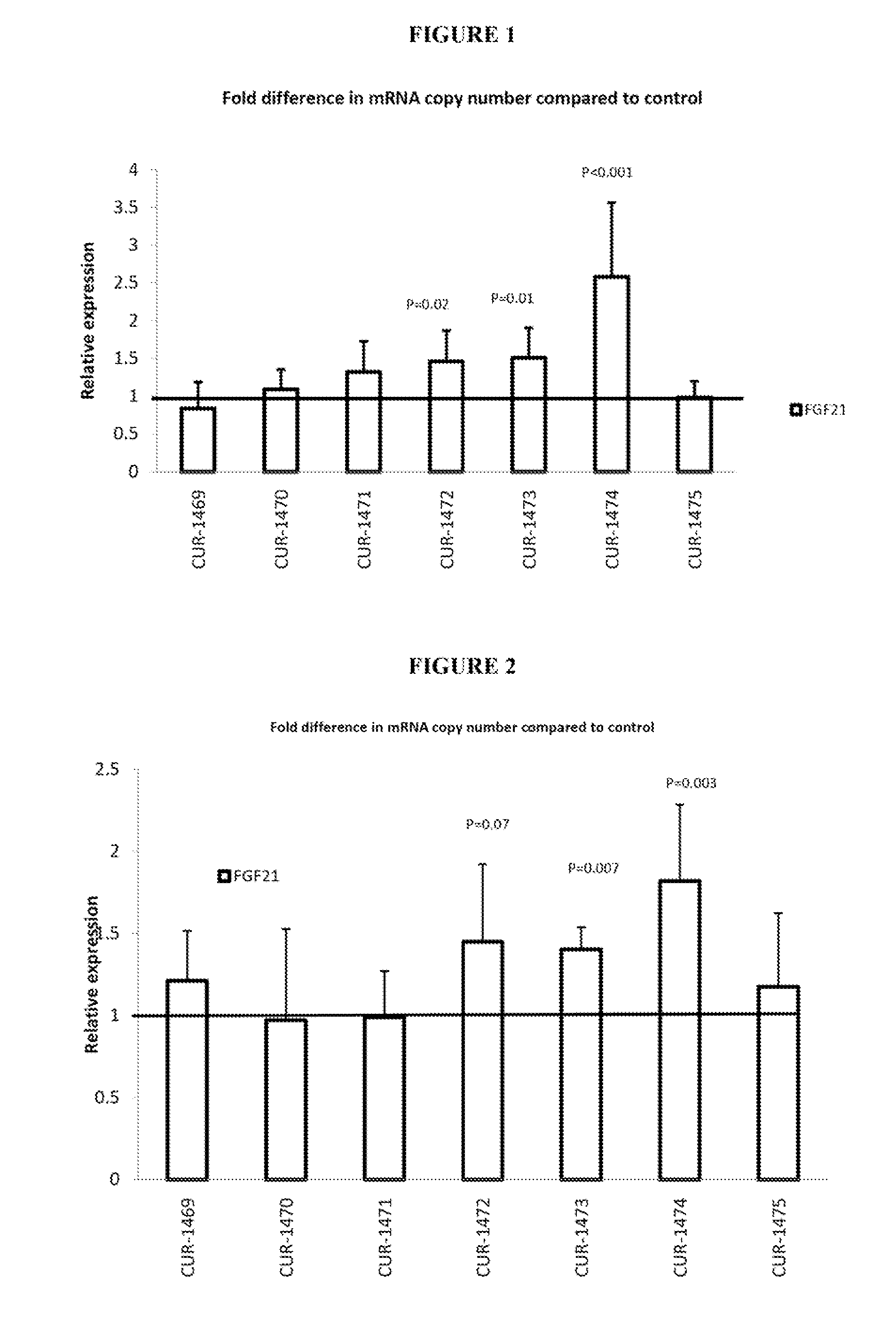Treatment of fibroblast growth factor 21 (FGF21) related diseases by inhibition of natural antisense transcript to fgf21
a technology natural antisense, applied in the field of treatment of fibroblast growth factor 21 (fgf21) related diseases by inhibiting natural antisense transcript to fgf21, can solve problems such as interference with rna splicing, transcription, translation, replication, etc., and achieve the effect of modulating function and/or expression
- Summary
- Abstract
- Description
- Claims
- Application Information
AI Technical Summary
Benefits of technology
Problems solved by technology
Method used
Image
Examples
example 1
Design of Antisense Oligonucleotides Specific for a Nucleic Acid Molecule Antisense to a Fibroblast Growth Factor 21 (FGF21) and / or a Sense Strand of FGF21 Polynucleotide
[0221]As indicated above the term “oligonucleotide specific for” or “oligonucleotide targets” refers to an oligonucleotide having a sequence (i) capable of forming a stable complex with a portion of the targeted gene, or (ii) capable of forming a stable duplex with a portion of an mRNA transcript of the targeted gene.
[0222]Selection of appropriate oligonucleotides is facilitated by using computer programs (e.g. IDT AntiSense Design, EDT OligoAnalyzer) that automatically identify in each given sequence subsequences of 19-25 nucleotides that will form hybrids with a target polynucleotide sequence with a desired melting temperature (usually 50-60° C.) and will not form self-dimers or other complex secondary structures.
[0223]Selection of appropriate oligonucleotides is further facilitated by using computer programs that...
example 2
Modulation of FGF21 Polynucleotides—Treatment of MCF-7 Cells with Antisense Oligonucleotides
[0231]All antisense oligonucleotides used in Example 2 were designed as described in Example 1. The manufacturer (IDT Inc. of Coralville, Iowa) was instructed to manufacture the designed phosphothioate bond oligonucleotides and provided the designed phosphothioate analogs shown in Table 1. The asterisk designation between nucleotides indicates the presence of phosphothioate bond. The oligonucleotides required for the experiment in Example 2 can be synthesized using any appropriate state of the art method, for example the method used by IDT: on solid support, such as a 5 micron controlled pore glass bead (CPG), using phosphoramidite monomers (normal nucleotides with all active groups protected with protection groups, e.g. trityl group on sugar, benzoyl on A and C and N-2-isobutyryl on G). Protection groups prevent the unwanted reactions during oligonucleotide synthesis. Protection groups are r...
example 3
Modulation of FGF21 Polynucleotides-Treatment of HepG2 Cells with Antisense Oligonucleotides
[0235]All antisense oligonucleotides used in Example 3 were designed as described in Example 1. The manufacturer (IDT Inc. of Coralville, Iowa) was instructed to manufacture the designed phosphothioate bond oligonucleotides and provided the designed phosphothioate analogs shown in Table 1. The asterisk designation between nucleotides indicates the presence of phosphothioate bond. The oligonucleotides required for the experiment in Example 3 can be synthesized using any appropriate state of the art method, for example the method used by IDT: on solid support, such as a 5 micron controlled pore glass bead (CPG), using phosphoramidite monomers (normal nucleotides with all active groups protected with protection groups, e.g. trityl group on sugar, benzoyl on A and C and N2-isobutyryl on G). Protection groups prevent the unwanted reactions during oligonucleotide synthesis. Protection groups are re...
PUM
| Property | Measurement | Unit |
|---|---|---|
| temperature | aaaaa | aaaaa |
| ionic strength | aaaaa | aaaaa |
| temperature | aaaaa | aaaaa |
Abstract
Description
Claims
Application Information
 Login to View More
Login to View More - R&D
- Intellectual Property
- Life Sciences
- Materials
- Tech Scout
- Unparalleled Data Quality
- Higher Quality Content
- 60% Fewer Hallucinations
Browse by: Latest US Patents, China's latest patents, Technical Efficacy Thesaurus, Application Domain, Technology Topic, Popular Technical Reports.
© 2025 PatSnap. All rights reserved.Legal|Privacy policy|Modern Slavery Act Transparency Statement|Sitemap|About US| Contact US: help@patsnap.com

